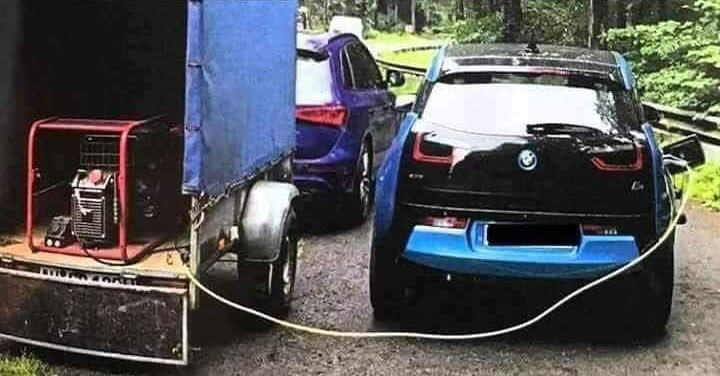Range, on the flat, just over 200 miles in summer. In winter lucky to get 100 miles. And in winter – no heating!
To suggest, as some ignorant people have, that electric cars ‘emit no CO2’ is absurd because the power stations that charge them do. To charge an electric vehicle (such as a Tesla), just once, requires the burning of 43 kilogram of coal.
A petrol car will require about 20 kilogram of petrol for the same distance. It follows that the electric car is emitting more than twice the CO2 of a petrol car.
Here are the sums:
Drax uses about 0.31 kilogram of coal per KWhr generated.
1 A Tesla battery is rated at 70 KWhr and fast charging is only 50% efficient. It will need 140 KWhr of electricity for a single charge; this works out as about 43 kilogram (0.31 × 140) of coal for a full charge.
The cost of electricity for the range available in a Tesla—200 miles in summer; 100 miles in winter—works out at £22.50. The petrol for 200 miles costs very little more and most of that cost is tax (currently about 60%) – about £28. In winter, for 100 miles, the petrol costs just £15.
During trials between 1927-30 of British steam locomotives a typical result was that, for a 500 ton express train, coal was consumed at the rate of 20 kg per mile.
2 Over 200 miles therefore 4000 kg was consumed. Scaling down to a 2 ton car: 4000÷250=16 kg coal. Even allowing for economies of scale, compare this to the 43 kg required by a Tesla.
Further issues
- Battery cycling – the deterioration of the capacity of a lithium battery with charging – must be allowed for, costing about £3 per cycle.
3 Fire: even small lithium batteries are liable to catch fire or even explode, releasing deadly toxins such as COS, HF, CO.
4 The huge dangers for occupants in event of an accident are obvious. Firehoses would only exacerbate the problem, causing electrocution of victims.
5 This has already happened: www.mirror.co.uk/news/world-news/richard-hammond-switzerland-car-crash-10599134
- Weight
The Tesla battery weighs 800kg—that’s nearly a ton—equivalent to 10 people. Battery/petrol equivalent weight ratio—in summer 50:1, in winter 100:1.
Further hazards
In winter, in severe conditions, electric cars become death traps. Firstly, the battery power halves every ten degree drop in temperature, so you are likely to get stuck in a snowstorm. Then there will be no heating in the car and a blizzard outside. You will freeze to death inside and, outside the car, you may die seeking help. This would not happen in a petrol car. A petrol car’s engine remains at full power down to the last drop of petrol and has plenty of heating. The electric car loses power almost immediately as the battery drains—and has no heating.
As most of the numpties, who think electric cars are viable, live in towns the above point doubtless passes them by, but the huge potential for traffic clogging due to ‘dead’ electric vehicles has not been considered
6 , nor has the issue of time to recharge. Currently an average petrol car takes about 5 minutes to fill up with petrol, pay and depart. If an electric car takes a minimum of 75 minutes to recharge, the queues are going to be astronomical and the time wasted also astronomical.
The BBC tried to take an electric car from London to Edinburgh. It took more than three days, slower than a stagecoach. Strangely, people sometimes need to get to places quickly.
In case anyone thinks that there is a miracle battery just over the horizon, I can absolutely assure him or her that there is not. Battery technology is mature, and, to quote Mr David Hume, “Miracles do not happen.” (at least in technology). Just where is all this power to come from anyway? The Climate Change Act requires that by 2045 all gas heating be replaced by electric heating and all cars be electric.
Besides the stupidity of turning huge amounts of electricity back into heat, clearly no one in government has done the maths. The results are horrendous!
Electric HGVs anyone?
Drax power station in Yorkshire 4 gigaWatt = 4,000,000 kiloWatt
17 million gas using households @ 30kW (to replace gas boiler) 17 million chargers for electric cars @ 8kW 38kW
Were these to be run on biomass (woodchips) as 50% of Drax already is, Plus we will need to dig up every street to lay much bigger cables. (assuming only one car per household) all needed at peak domestic demand (5pm-10pm): 38kW × 17,000,000 = 646,000,000 kW ÷ 4,000,000 = 160 Drax sized power stations this would consume, annually, the total annual timber harvest of the USA!
Philip Foster MA (Nat. Sci.) 1 Barnfield, Hemingford Abbots, Huntingdon PE28 9AX
01480 399098 philip.foster17@ntlworld.com

